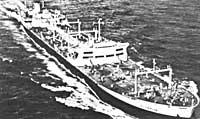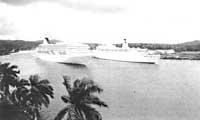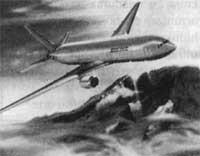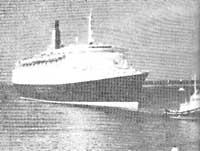History of Naval Industry: XII Trade
1987/08/01 Azkune Mendia, Iñaki - Elhuyar Fundazioa Iturria: Elhuyar aldizkaria

However, during the Second World War, European and Japanese fleets were almost destroyed. 70% or 80% of sinking. Also the shipyards, very affected by the bombings of planes.
But five years after the war, in 1950, the merchant fleet stood at eighty million tons, in 1955 at one hundred million and in 1965 it had spent two hundred million. Since then it has suffered a continuous growth thanks to the development of the world economy. On the other hand, industry and construction demand faster, safer and cheaper means of transport.
However, raw materials are the ones that have most influenced the markets. Previously, large quantities of coal were transported from Britain and North America and elsewhere to the whole world. Steel, of course. Subsequently, oil transport has been fundamental for the functioning of the entire world economy. To do this, the oil tankers are making long trips through the seas.
It is an oil boat, long, of little height and with the bridge on the stern of the ship. Along with oil consumption, oil tankers have also increased considerably.
In 1938 280 million tons of oil were burned in the world and in 1958 (20 years later) 700 million tons. In 1966 more than 1 billion tons of oil were consumed and has since suffered a continuous rise.
All this has brought with it the proliferation and growth of the oil tankers. The shipping companies have looked a lot at the cost of transportation. For this reason, they have built increasingly large oil tankers. The Gluckauf, built in 1886, was 3,000 tons, and the most terrible in its day. Today, however, many oil tankers have overlooked the 100,000 tons.
But this increase has not been abrupt. In 1920 they were manufactured between 5,000 and 7,000 tons, and from 1930 begins in France the trend to the construction of major oil tankers. Between 1932 and 1936 three large oil tankers of 13,500 tons, 18,500 tons and 21,500 tons were shipped respectively. Those boats surprised people, but the shipping company did not exaggerate them. Too dangerous for the construction of such large ships. In Britain, moreover, the formula called twelve, twelve, twelve was fully valid: 12,000 tons, 12 miles/hour of speed and 12 tons of daily fuel consumption.
The British trend lasted a long time and in the second world war they embarked on an oil tanker of 16,000 tons at most, despite the extreme need for oil. In 1952, however, the French totally rejected the aforementioned norm, twelve, twelve, twelve, with a new oil tanker Bérénice of 32,000 tons. Three years later they began to build 37,000 tons and in 1956 the Americans advanced, building 52,000 tons. The Japanese were also not asleep and managed to disembark 85,000 tons.
Another limit for oil transport was: Suez Canal. There the ships passed and it was impossible to pass more than 35,000 or 40,000 tons. Later the channel was nationalized.
Despite the obstacles, the carriers began to use larger oil tankers from southern Africa. Sailing in southern Africa was as cheap as passing from Suez a 40,000 tonne boat. The construction of oil vessels of about 100,000 tons began, at the same time as the transport speed of 14 to 19 miles/hour was accelerated.
Currently, the presence of oil tankers of 130,000 tons or more is relatively common, but this increase also has its limitations. On the one hand, the dimensions of the ports and, on the other, the incessant extension of the ships. On the other hand, the cost of transportation also establishes its limits.
The truth is that the cheapest system to transport large quantities and pesos is that of the merchants of the sea, and it seems that it will continue for years. However, thanks to the atomic propulsion, the submarine oil tankers begin to test the interconnection and telework.
However, there is another situation regarding the transport of passengers (persons). The competition of the planes is very hard. Until 1958, for example, there were more passengers sailing, but since then people have preferred air transport. In 1913, 2,576,000 passengers traveled to Europe and America by sea. During the First World War, the cupbearer was greatly reduced and has been growing ever since.

In 1938, however, airlines began to offer their services. In that same year, although the number of passengers grew, the transit through America fell by 150,000 people compared to the year before the sea. In 1952 there were 840,000 passengers who chose the boat, but the most expected were the 500,000.
In 1957 the figures were matched: 1,030,000 passengers each. Since then, what happened is known; planes dominate the transport of people.
At present there are other projects among the shipping companies. With their luxury boats, comfort and safety, they compete to attract people to tourism. If the planes are fast in front of the ships, maritime navigation also has its charm. And who would not like to spend a couple of weeks calm down the Mediterranean, for example on the boat?

Gai honi buruzko eduki gehiago
Elhuyarrek garatutako teknologia




